Heating without batteries, is it possible? Features of heating using warm floors
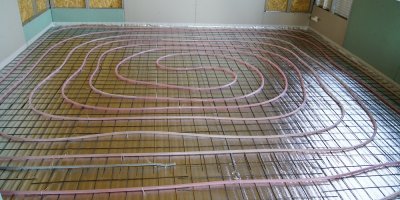
In the cold season, insufficient heating often becomes a problem. To solve the heat issue, people usually turn to heaters, but there are also more advanced underfloor heating systems on the market.
The room is heated from the bottom up, which helps to achieve the optimal temperature in the house. Warm floors are easy to install and serve reliably for many years.
Content
Heating your home in a new way
Rooms with heated floors are much more comfortable, they warm up faster and retain heat longer.
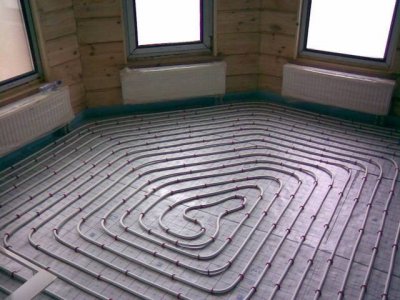
This is due to the principle of heat flow distribution, diametrically opposed to the usual: cold air below, warm air is concentrated near the ceiling.
The new system heats the air exactly where cold air usually falls. Warm air comes from the floor and cools down at head level, which is good for health.
The heat carrier, located under the floor surface and not concentrated in one point, evenly releases heat into the space, eliminating the appearance of cold zones.
Advantages over batteries
Advantages:
- Large heating area and temperature distribution throughout the room, unlike batteries that heat small areas.
- Saving on heating the coolantIts temperature may not be high, and there will be no lack of heat.
- Saving on heating billsA warm room does not require additional heating.
- Ease of management and creating the necessary microclimate.
- Saving space. The system will eliminate the need for space-consuming heaters.
- Easily hidden under the floor.
- Durability: can work up to fifty years.
- Flexibility: The owner himself decides with what intensity each room of the house will be heated.
Cons
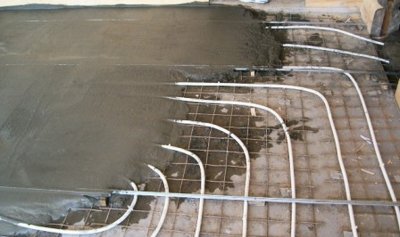
Flaws:
- Slow heating and cooling, which becomes noticeable when the temperature outside changes.
- Complex installation, equivalent to a full renovation.
- High cost.
- The need to raise the floor level.
- High power consumption (the heat in the house depends solely on the availability of electricity).
- Difficulties with repair: It is not always easy to find the place of breakdown in a single closed system.
- You need to think about the flooringA carpet is not compatible with such a floor.
- It is not always possible to rearrange furniture or all furniture should be raised off the floor.
If earlier this method of heating the room was used as an additional one, then modern technologies allow to make it unique and autonomous. It can be installed so that important rooms (children's room, bedroom) are warmed more than auxiliary ones (hallway). Or even to heat only one room (bathroom or loggia).
Types of heated floors
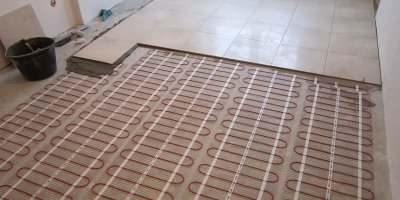
Warm floor can be water or electric, when the carrier is either water circulating through pipes or an electric cable, the operation of which is coordinated by a thermostat.
Warm floors powered by water supply systems are installed in private homes, as they require a large number of pipes. Placed in an apartment, such a floor may block the movement of the coolant in the riser. Special heat exchange units are required to eliminate this problem.
Attention! The installation of such an individual heating system requires permission from the management company.
The most popular and permitted type of flooring in an apartment is electric flooring., which does not require a full repair, is safe for neighbors (no water breakthrough), and is relatively easy to install.
Water, powered by central heating or gas boiler
This type of floor has a simple operating principle: A heat carrier (ethylene glycol or water) circulates through the pipes, heated either by a gas boiler or by central heating. The pipes are laid under the floor covering and poured into the screed.
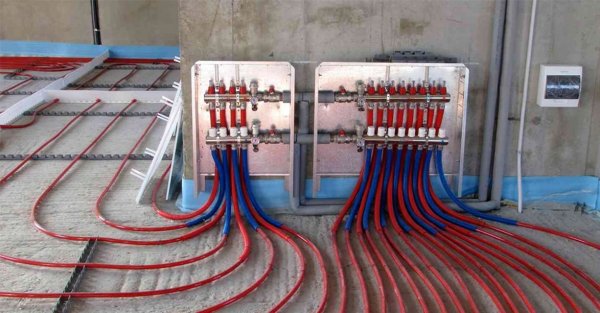
Photo 1. Installation of a water-heated floor. A special manifold unit is required for installation of the system.
Pros:
- Ecological and safe according to sanitary standards.
- Saving heat and the ability to maintain a comfortable temperature at a low water temperature.
- Lack of central heating batteries benefits the premises.
- With expensive installation, such floors much more economical and pays for itself quickly.
- No electromagnetic field, the presence of which is blamed on electrical systems.
Warm water floors are widely used to heat large rooms with high ceilings. The disadvantages of installing it in an apartment are obvious:
- Labor intensity of repair.
- Height not less than 10 cmThis is critical for the apartment.
- To make your home comfortable, you need to heat up a large amount of water. The system will not be able to heat the room quickly.
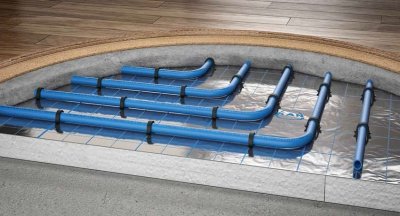
- Not very reliable. If a pipe bursts, the neighbors below may be flooded.
- Large weight of the couplerNot every foundation and ceiling can withstand it.
This heating option is considered ideal for a private home., especially if there is a gas boiler, which simultaneously heats water for household needs and heat. In addition, it does not depend on power outages.
Electric for bathroom, balcony and other rooms
It differs from water in that the cable acts as a heating element, which either has to be laid independently, or it is already laid in mats that do not require strict order in laying. The cable is powered by electricity, and the floor heating is regulated by thermostats in the house. Or a special carbon film is heated, which is called infrared.
This type of flooring is perfect for an apartment., and with proper installation and reasonable use, not only does it not consume excess energy, but will also help save it. Advantages:
- Versatility of the heating system, which does not require permission to install.
- The heating element is hidden, there can be a normal floor on top.
- A good microclimate is created, without drying the air.
- Humidity doesn't matter, because the wires are protected.
- Perfect for heating loggias and bathrooms (removes excess moisture).
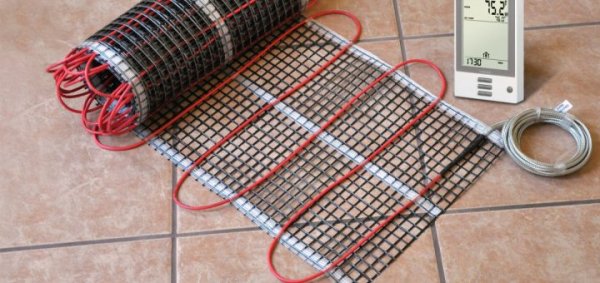
Photo 2. Electric heated floor. It is a grid with a cable attached to it, and a thermostat is also included.
Flaws:
- High power consumption.
- Ineffective as a sole heating source — not suitable for severe winters.
Energy consumption depends on the on/off cycles, which are tied to the degree of insulation of the building. According to the inexorable law of physics, the heater will take as much energy as the heat the house loses naturally. Therefore, Before laying the floor, it is worth estimating the heat loss.
It is not difficult to reduce your energy costs if you consider the following indicators:
- Regional climate and average winter temperatures.
- Building orientation and wind rose.
- The structure of the building and its materials (heat losses depend on this).
- The volume and quality of the insulation work performed.
- The purpose of the room in which the heated floor will be installed.
- Desired temperature.
Such things are calculated by specialists, but you can try to do it yourself, using programs on the Internet.
Film
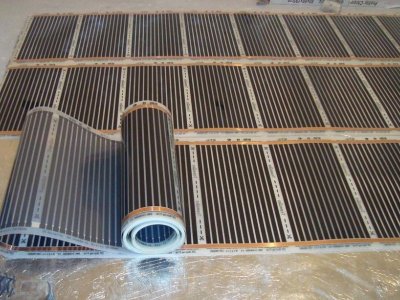
It has appeared on the market recently. Here the heating element is a special carbon film, which is sometimes called infrared.
When connected to the network, it emits infrared rays and metal anions (copper or aluminum). This new material is truly versatile:
- May be, both auxiliary and main heating method.
- Heats not only any room, but also open air areas. Mounted on walls and ceilings.
- Installs quickly, can be easily removed and moved to a new location.
- The film is divided into sections that are easy to separate from the roll and provide spot heating.
- Can be laid under both tiles and laminate.
Important! To prevent heat from escaping to the neighbors below, or simply into the ground, it is better to lay it under the floor heat-reflective lining.
Flaws:
- Cannot be installed in damp areas (bath or sauna).
- Complete dependence on electricity in the house.
Cable type
The cable is laid out in a specific pattern, filled with cement (screed) and covered with a finishing coating on top. The cable heats the floor surface to the desired temperature and switches off until the air becomes cooler.
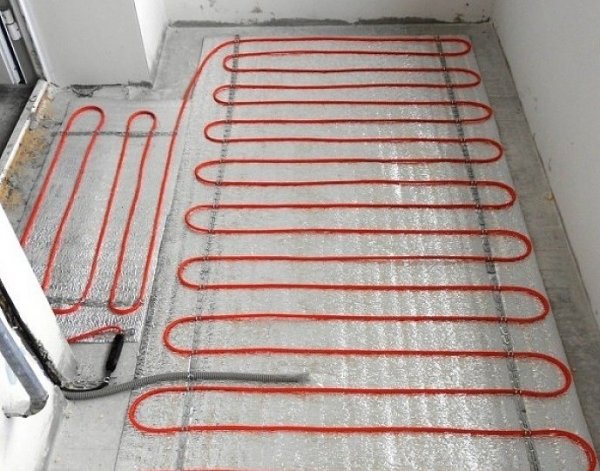
Photo 3. Installation of cable heated floor on the balcony. The system is laid on a special insulation.
Pros:
- Convenient for installation in small spaces.
- Service life about 25 years old.
- Excellent sealing: works even in wet concrete.
- It costs less than other heated floors.
Cons:
- Cable gets very hot.
- The floor rises quite high, which may be unacceptable in an apartment with low ceilings.
Attention! Cable should bend around furniture in the house, otherwise without air exchange it will heat up a lot, which will lead to its breakage. After laying the floor, it is almost impossible to rearrange the furniture in a new way.
DIY Underfloor Heating System
It is possible to lay it yourself, reducing the need for specialists to a minimum. Installation of heated floors is not too complicated, and with the modernization of products it is even easier. The preparatory stage of choosing the gender and calculations is difficultIt makes sense to follow the manufacturer's instructions.
Preparation
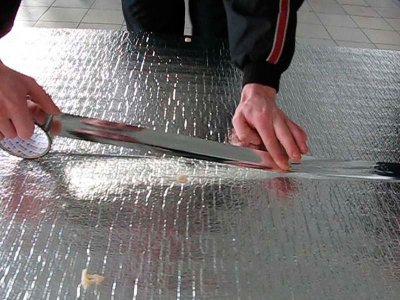
Floor must be leveled and free of dirt and dustIf the ceilings in the apartment are low, it is permissible to strip the floor down to the ceiling in order to reduce the height of the final structure.
Then it is laid down insulation - polystyrene, and reflective of heat multifoil.
A reinforcement mesh is placed on it, to which the heating pipes will be tied. Most often, a special substrate is used, into which the pipes are conveniently placed.
Laying pattern
The pipes are placed on the base and secured. The pattern can be "snake", "double snake" and "snail"There are other designs, but these are used more often. The print depends on the location of the control devices and the area of the room.
Next, it is installed collector, distributing the coolant in the pipes, and thermostat, which is connected to the temperature sensor.
Connection: via a riser using a pump, single-pipe and double-pipe wiring
There are three ways to connect to the central heating system:
- Through the riser: The circulation pump supplies liquid, the amount of which is regulated by the thermostat. The thermostat controls the heating limit and stops the system.
- Single pipe layout - provides heating for each room separately.
- Double pipe — convenient if there are several risers.
Laying and pouring
The pipes are filled with water and covered with concrete screed. Before this, a test run is made to ensure that the system is operational. The concrete screed needs time to harden.
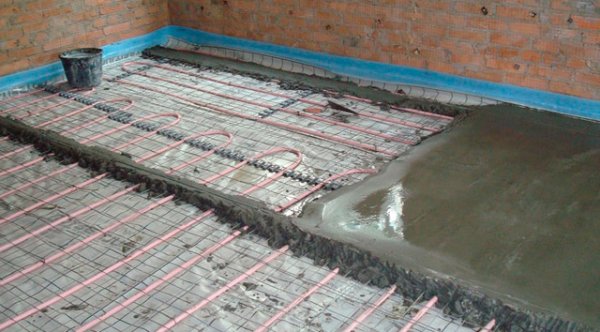
Photo 4. Installation of electric cable underfloor heating. The entire system is filled with concrete screed.
Launch
After the screed has completely hardened, you can start the system. first weakly, then at full power. If everything went well and there are no problems, the final coating is laid.
Important! The decorative floor can be laid and the system can be used no earlier than three weeks after pouringThe manufacturer indicates the exact period on the packaging of the building mixture.
Useful video
Watch the video to learn how to install underfloor heating yourself.
Choosing Underfloor Heating
When choosing a heating system, they focus on the fact that how exactly is the house supposed to be heated, whether the chosen method will be the only one, or only an auxiliary one. The price of the purchased product directly depends on this. Correct installation is important.
Control elements also require attention, since they are responsible for creating comfort in the room. It is worth considering the complexity of installation And possibilities of future exploitation.







